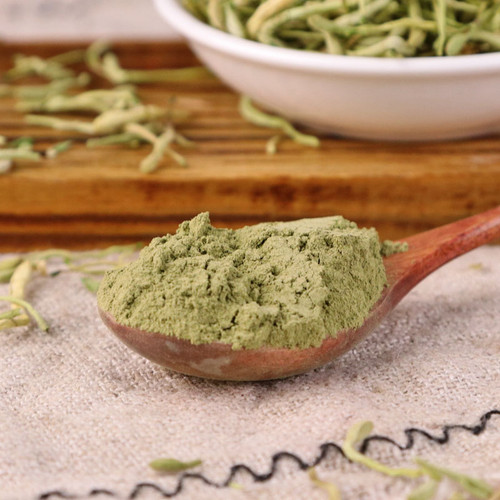Product Overview
Parts used: Dried flower bud
TCM category: Herbs that clear Heat and relieve Toxicity
TCM nature: Cold
TCM taste(s): Sweet
Meridian affinity: Stomach Heart Lung
Scientific name: Lonicera japonica
Other names: Golden-and-silver honeysuckle, Japanese honeysuckle
Use of honeysuckle flowers (Jin Yin Hua) in TCM
Please note that you should never self-prescribe TCM ingredients. A TCM ingredient is almost never eaten on its own but as part of a formula containing several ingredients that act together. Please consult a professional TCM practitionner, they will be best able to guide you.
Preparation: Dry flower buds immediately after harvest. The temperatures should be tightly controlled: first dry at 30 - 35 °C during 2 hours, then at 40 °C for 5 - 10 hours and finally at 45 - 50 °C during 10h. During drying the flower buds shouldn't be turned around otherwise they'll turn black.
Dosage: 10 - 20g
Main actions according to TCM*: Clears Heat and dispels toxicity. Dispels Wind-Heat derived from an External pathogen. Expels Damp-Heat from the Lower Burner. Relieves Carbuncles.
Primary conditions or symptoms for which honeysuckle flowers may be prescribed by TCM doctors*: Carbuncles Boils Erysipelas Dysentery Pharyngitis Acne Tonsillitis Laryngitis Sore throat
Contraindications*: This herb should not be used by those with Deficiency in the Spleen/Stomach when there is Cold or diarrhea. It should be used carefully when there is Qi or Yin Deficiency.
Common TCM formulas in which honeysuckle flowers are used*:
For hypertension combine honeysuckle flowers with dandelions (Pu Gong Ying) and chrysanthemum flowers (Ju Hua).
For spirochete diseases such as syphilis and Lyme's disease combine honeysuckle flowers with dandelions (Pu Gong Ying), smilax glabra roots (Tu Fu Ling), liquorice (Gan Cao), dittany root bark (Bai Xian Pi) and purslane (Ma Chi Xian).
For Summer Heat (heat stroke) combine honeysuckle flowers with vietnamese balm (Xiang Ru) and hyacinth beans (Bai Bian Dou).
For severe high fever combine honeysuckle flowers with baikal skullcap roots (Huang Qin) and goldthread rhizomes (Huang Lian).
For swollen and painful sore throat combine honeysuckle flowers with platycodon roots (Jie Geng) and greater burdock fruits (Niu Bang Zi).
For severe colds, flu or upper respiratory tract infections combine honeysuckle flowers with forsythia fruits (Lian Qiao), platycodon roots (Jie Geng), greater burdock fruits (Niu Bang Zi), wild mint (Bo He), fermented soybeans (Dan Dou Chi), lophatherum herbs (Dan Zhu Ye), common reed rhizomes (Lu Gen), liquorice (Gan Cao), notopterygium roots (Qiang Huo) and woad roots (Ban Lan Gen).
For toxic Heat with sores, erysipelas, mumps and painful throat obstruction combine honeysuckle flowers with woad leaves (Da Qing Ye).
For hot phlegm and lung abscess combine honeysuckle flowers with wax gourd (Dong Gua), platycodon roots (Jie Geng) and houttuynia (Yu Xing Cao).
For sore throat and hoarseness combine honeysuckle flowers with chinese white olives (Qing Guo) and common reed rhizomes (Lu Gen).
Key TCM concepts behind honeysuckle flowers (Jin Yin Hua)'s properties
In Traditional Chinese Medicine (TCM), honeysuckle flowers are plants that belong to the 'Herbs that clear Heat and relieve Toxicity' category. Herbs in this category are used to clear inflammatory and infectious conditions, referred to as 'Internal Heat' in TCM. This is why most of the herbs in this category will have both antibacterial and antiviral properties. In TCM one has too much 'Heat' in their body as a result of a deficiency of 'Yin' (which is Cold in nature, see our explanation on Yin and Yang) or, more commonly, an excess of Yang (Hot in nature). Herbs that clear Heat and relieve Toxicity treat the latter while, at the same time, removing infectious toxins from the body. As such they tend to be Cold or Neutral in nature.
As suggested by its category honeysuckle flowers are plants that are Cold in nature. This means that honeysuckle flowers typically help people who have too much "heat" in their body. Balance between Yin and Yang is a key health concept in TCM. Those who have too much heat in their body are said to either have a Yang excess (because Yang is Hot in nature) or a Yin deficiency (Yin is Cold in Nature). Depending on your condition honeysuckle flowers can help restore a harmonious balance between Yin and Yang.
Honeysuckle flowers also taste Sweet. The so-called "five elements" theory in Chinese Medicine states that the taste of TCM ingredients is a key determinant of their action in the body. Sweet ingredients like honeysuckle flowers tend to slow down acute reactions and detoxify the body. They also have a tonic effect because they replenish Qi and Blood.
The tastes of ingredients in TCM also determine what organs and meridians they target. As such honeysuckle flowers are thought to target the Stomach, the Heart and the Lung. In TCM the Stomach is responsible for receiving and ripening ingested food and fluids. It is also tasked with descending the digested elements downwards to the Small Intestine. In addition to regulating blood flow, the Heart is believed to be the store of the "spirit" which basically refers to someone's vitality. In addition to performing respiration, the Lungs are thought to be a key part of the production chain for Qi and the body fluids that nourish the body.
Use of honeysuckle flowers (Jin Yin Hua) as food
Honeysuckle flowers are also eaten as food. It is used as an ingredient in dishes such as Honeysuckle Pound Cake or Honeysuckle syrup.









